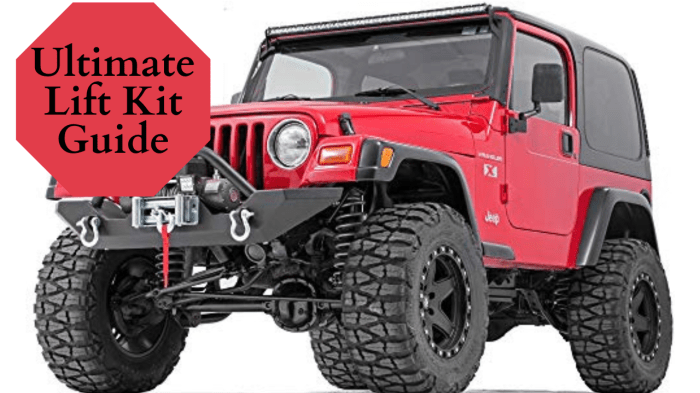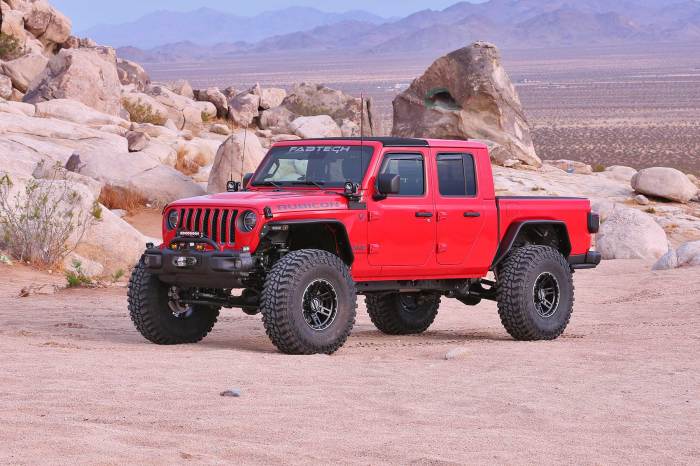Jeep lift kits dramatically transform your vehicle’s capabilities and appearance. Elevating your Jeep provides increased ground clearance, crucial for navigating challenging terrains and conquering obstacles. This upgrade opens up a world of off-road possibilities, from tackling rugged trails to simply enjoying a more commanding view of the road ahead. Choosing the right lift kit depends on your specific needs and driving style, encompassing various factors such as budget, desired lift height, and intended use.
Beyond the functional advantages, a lift kit significantly alters the aesthetic of your Jeep, giving it a more aggressive and imposing stance. This visual upgrade complements performance enhancements, creating a vehicle that’s as capable as it is striking. However, it’s important to consider the potential impact on your Jeep’s handling and stability, requiring careful consideration and potentially professional installation.
Taking your Jeep off-road to explore rugged terrains requires more than just a spirit of adventure. A significant upgrade for many Jeep enthusiasts is a lift kit, dramatically altering the vehicle’s capabilities and appearance. This comprehensive guide delves into the world of Jeep lift kits, exploring various types, installation considerations, and crucial factors to consider before making your purchase.
We’ll cover everything from budget-friendly options to high-performance systems, ensuring you have the information needed to make an informed decision.
Understanding Jeep Lift Kits: Types and Components
Jeep lift kits aren’t one-size-fits-all. They come in various types, each designed to achieve specific height increases and address different off-roading needs. Understanding these differences is crucial for selecting the right kit for your Jeep and driving style.
Body Lifts
Body lift kits increase the vehicle’s height by raising the body relative to the frame. This is generally a simpler and less expensive option compared to suspension lifts. However, body lifts don’t improve suspension articulation or ground clearance as significantly. They primarily enhance the vehicle’s appearance and allow for larger tires. Body lifts typically involve installing spacers between the body and the frame.
Suspension Lifts, Jeep lift kit
Suspension lifts are the more comprehensive and often preferred option. They modify the suspension system itself, providing improved ground clearance, articulation, and ride quality. There are several subtypes of suspension lifts:
Spindle Lifts
Spindle lifts are a relatively simple and affordable type of suspension lift. They involve replacing or adding components to the vehicle’s spindles, effectively increasing the ride height. However, they offer a more modest lift compared to other suspension lift types and may impact the steering geometry.
Coil Spring Lifts
Coil spring lifts are a popular choice, offering a balance between cost and performance. They involve replacing the factory coil springs with taller ones, increasing the vehicle’s ground clearance. These kits often include new shocks or shock extensions to accommodate the increased ride height.

Leaf Spring Lifts (for Jeep models with leaf springs)
Jeeps with leaf springs in their suspension systems (some older models) use leaf spring lift kits. These involve replacing the factory leaf springs with longer ones or adding additional leaves to increase the ride height. This type of lift often provides a stiffer ride but can significantly increase ground clearance.
Long-Arm Suspension Lifts
Long-arm kits are a more advanced and expensive option. They replace the factory control arms with longer ones, improving suspension articulation and allowing for greater wheel travel. This results in a smoother and more controlled ride, particularly on challenging terrain. These are often preferred for serious off-roading.
Component Considerations: Shocks, Bump Stops, and More
A complete lift kit typically includes more than just the primary lift components. Essential elements often included are:
- Shocks (Dampers): These control the suspension’s movement, impacting ride quality and handling. New shocks are crucial for a safe and comfortable ride after a lift installation.
- Bump Stops: These limit the suspension’s upward travel, preventing damage to components when encountering obstacles.
- Control Arms (for some lifts): These connect the suspension to the chassis, influencing handling and articulation.
- Track Bars or Panhard Bars: These maintain axle alignment, crucial for safe and stable handling.
- Brake Lines (often require extension): Extended brake lines accommodate the increased suspension travel.
- Driveshaft(s) (potentially): Depending on the lift height, driveshafts might need to be replaced or modified to prevent vibrations.
Choosing the Right Jeep Lift Kit: Factors to Consider
Selecting the appropriate lift kit requires careful consideration of several factors:
- Jeep Model and Year: Different Jeep models have varying suspension designs, requiring specific lift kits.
- Intended Use: Are you primarily using your Jeep for light off-roading, moderate trails, or extreme rock crawling? This dictates the required lift height and suspension articulation.
- Budget: Lift kits range significantly in price, from a few hundred dollars to several thousand. Determine your budget before starting your search.
- Lift Height: Higher lifts provide greater ground clearance but can impact handling and potentially require additional modifications (like longer driveshafts).
- Tire Size: The lift height will influence the maximum tire size you can fit without rubbing. Consider this carefully.
- Installation Difficulty: Some kits are easier to install than others. Consider your mechanical skills or whether you’ll need professional installation.
- Brand Reputation: Choose reputable brands known for quality and reliability.
Installation of a Jeep Lift Kit: A Step-by-Step Overview
Installing a lift kit can be a challenging project, requiring mechanical skills and the right tools. While a detailed step-by-step guide is beyond the scope of this article, it’s crucial to understand that professional installation is often recommended, especially for complex suspension lifts. Improper installation can lead to safety hazards and damage to your Jeep.
Generally, installation involves disconnecting various suspension components, installing the new lift components, and reassembling the system. This often involves using specialized tools and torque wrenches to ensure proper tightening of bolts and nuts. Refer to the specific instructions provided with your chosen lift kit.
Frequently Asked Questions (FAQ): Jeep Lift Kit
- Q: How much does a Jeep lift kit cost? A: Costs vary widely depending on the type of lift, brand, and components included. Expect to pay anywhere from a few hundred dollars for a simple body lift to several thousand for a high-performance long-arm suspension lift.
- Q: Will a lift kit void my warranty? A: This depends on your vehicle’s warranty and the modifications made. Check your warranty terms and conditions, and consider discussing modifications with your dealer before installation.
- Q: How much lift is too much? A: Excessive lift height can negatively impact handling, stability, and potentially require extensive modifications. Choose a lift height appropriate for your intended use and driving style.
- Q: Do I need to get an alignment after installing a lift kit? A: Yes, a wheel alignment is almost always necessary after installing a lift kit to ensure proper handling and tire wear.
- Q: Can I install a lift kit myself? A: This depends on your mechanical skills and the complexity of the kit. Simple body lifts may be manageable for experienced DIYers, but complex suspension lifts often require professional installation.
- Q: What size tires can I use after a lift? A: The maximum tire size depends on the lift height and other factors. Always check for potential rubbing issues before installing larger tires.
Conclusion: Elevate Your Jeep Adventure
Choosing and installing a Jeep lift kit is a significant upgrade that can transform your off-road experience. By carefully considering the factors discussed in this guide, you can select the right kit to match your needs and budget. Remember to prioritize safety and consider professional installation for complex lift kits. Happy trails!
References
While specific product links are avoided to maintain best practices and avoid bias, reputable sources for further research include automotive forums dedicated to Jeep modifications and reputable parts retailers specializing in Jeep accessories. Always consult multiple sources before making a purchase decision.
Call to Action
Ready to take your Jeep to the next level? Start exploring Jeep lift kits today! Research different brands and types, and don’t hesitate to consult with experienced Jeep enthusiasts or professionals for personalized advice.
Essential Questionnaire
What are the different types of Jeep lift kits?
There are several types, including body lifts (raising the body relative to the frame), suspension lifts (modifying the suspension components), and leveling kits (adjusting the front and rear heights).
How much does a Jeep lift kit cost?
Costs vary greatly depending on the kit’s type, brand, and lift height. Prices range from a few hundred to several thousand dollars.
Do I need professional installation for a Jeep lift kit?

While some simpler kits can be installed at home, professional installation is often recommended, especially for more complex kits, to ensure proper alignment and safety.
Will a lift kit affect my Jeep’s warranty?
Installing a lift kit may void certain aspects of your vehicle’s warranty. Check with your dealer to understand the implications.
